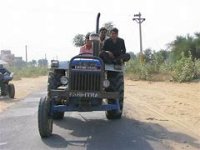Well, it finally happened. I was blowing my 1500' drive (steep, curvy) with the K5240, when I noticed the right front tire was going flat. Haven't figured out why yet (the tire is still at the shop; I suspect low tire pressure), but proceeded about 50' to one of the only turnarounds on the drive. After turning around, I lowered the bucket to the ground and "bucket-backed" until the cutting edge could ski down the drive to the shed...about 1000'. Going straight it worked fine, taking all the load off the front end. The tractor does not have individual rear wheel differential brakes, so that wasn't an option for steering.
When I needed to change direction slightly, I'd raise the bucket until the left wheel engaged the ground, then turned, and lowered the bucket again. I'm cautiously optimistic I did no damage to the tire bead. Stay tuned.
But it raises the question should this (flat tire in a difficult location to access) ever happen:
If one lowers the bucket, pushes the axle down as far as it will go on the good side, and put a block of steel between the axle and the tractor frame (there's already a little "flat" on the axle to land on at end of travel), can one drive on three wheels at low speed short distances safely? Might be a dumb question but don't want to try it without some experienced input.
When I needed to change direction slightly, I'd raise the bucket until the left wheel engaged the ground, then turned, and lowered the bucket again. I'm cautiously optimistic I did no damage to the tire bead. Stay tuned.
But it raises the question should this (flat tire in a difficult location to access) ever happen:
If one lowers the bucket, pushes the axle down as far as it will go on the good side, and put a block of steel between the axle and the tractor frame (there's already a little "flat" on the axle to land on at end of travel), can one drive on three wheels at low speed short distances safely? Might be a dumb question but don't want to try it without some experienced input.

